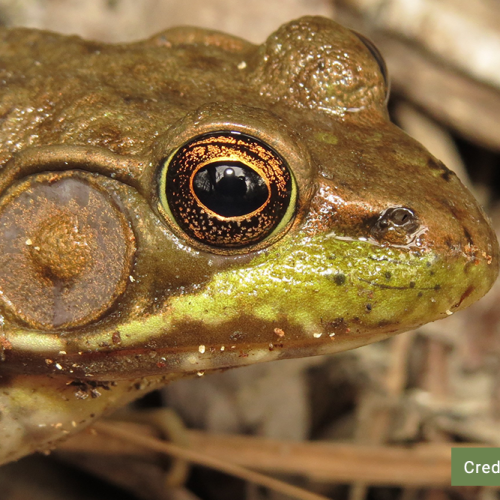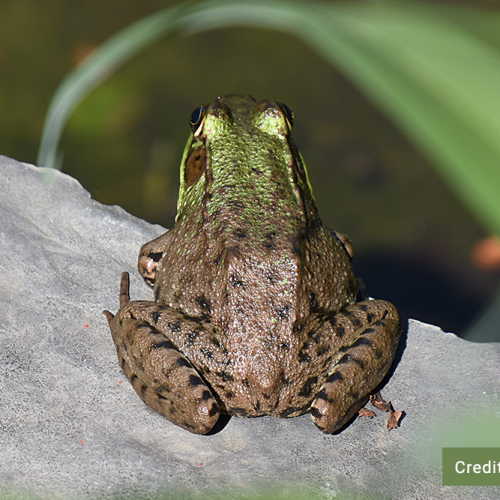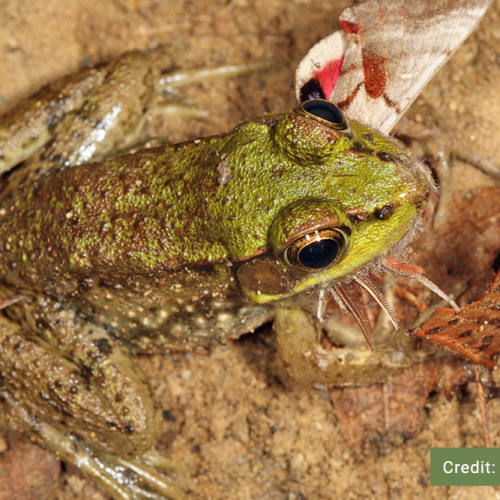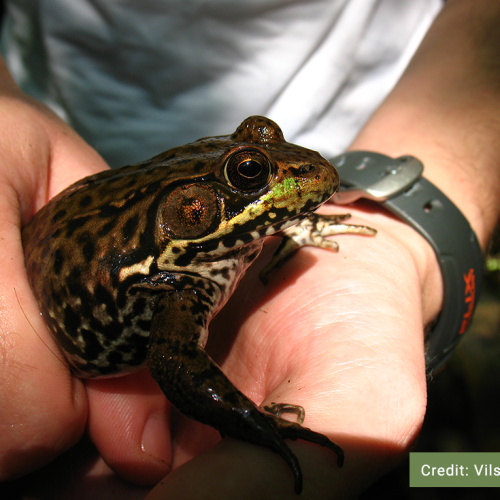Credit: Ryan Hodnett
Green Frog
Lithobates clamitans
Description
Other names: Rana clamitans
Green Frogs are an introduced species to British Columbia. They are a large frog reaching up to 11 cm, with a distinct tympanumDefinition:The ear opening in many amphibians, reptiles, and insect. In amphibians, it is normally covered by a circular membrane. and prominent dorsolateral foldsDefinition:Visible raised ridges of skin that run down part of all of the length of the back, usually on the sides.. In males, the tympanum is nearly twice the diameter of the eye, while in females it is approximately the same size as the eye. The dorsolateral ridges on the Green Frog do not reach the groin and are disrupted part way down the back. Green Frogs are typically – you guessed it – green, although they may range to bronze or brown with a green upper lip. Some Green Frogs have irregular spotting on the back and the hind legs have dark bars. They belly is white with dark mottling and may have a yellow tinge. Green Frog tadpoles have long tails with a large tail fin and are olive green with dark markings and a cream-coloured belly. Tadpoles reach 8-10 cm before metamorphosis.
Listen to the Indigenous words for “frog” here!
Green Frog Call
The call of the Green Frog is deep and twangy “gung” that is loud and distinct. It has been described as similar to the sound of a rubber band being plucked, or like a loose banjo string.
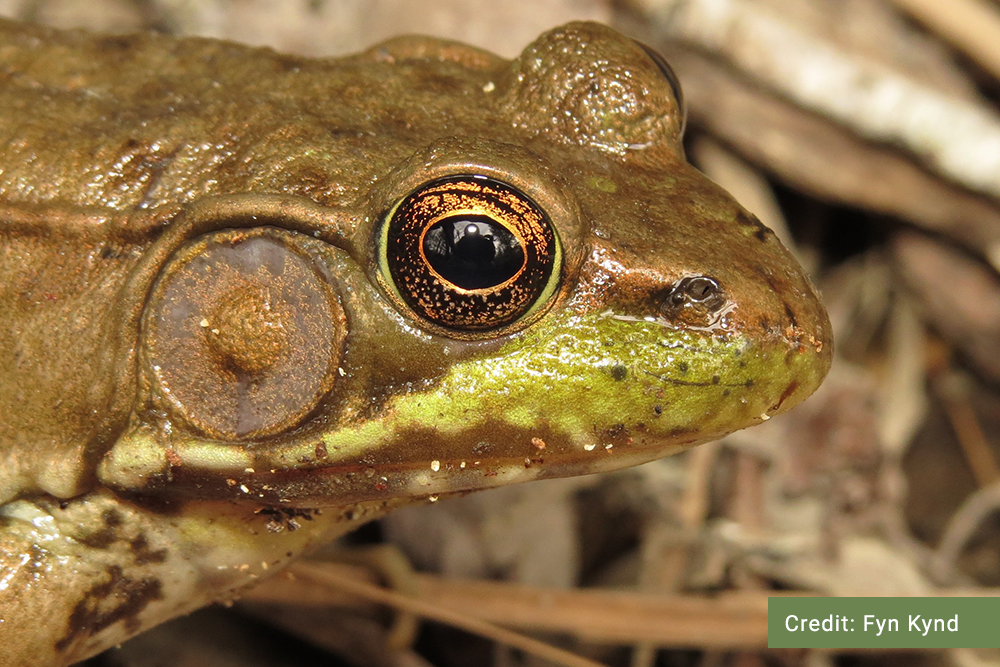
Green Frog Call
The call of the Green Frog is deep and twangy “gung” that is loud and distinct. It has been described as similar to the sound of a rubber band being plucked, or like a loose banjo string.
Similar Species
Green Frogs may be confused with American Bullfrogs, although Bullfrogs lack dorsolateral ridges and are much larger when full grown. They can often be found in the same areas as Bullfrogs, but are typically found on land 2-3 meters from the water while Bullfrogs are usually found in water.
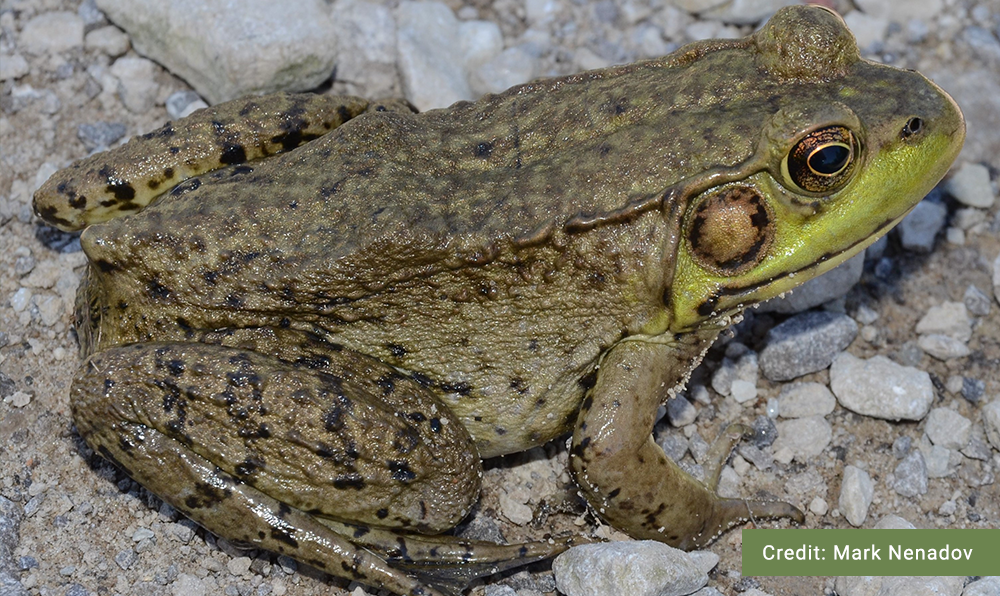
Green Frog
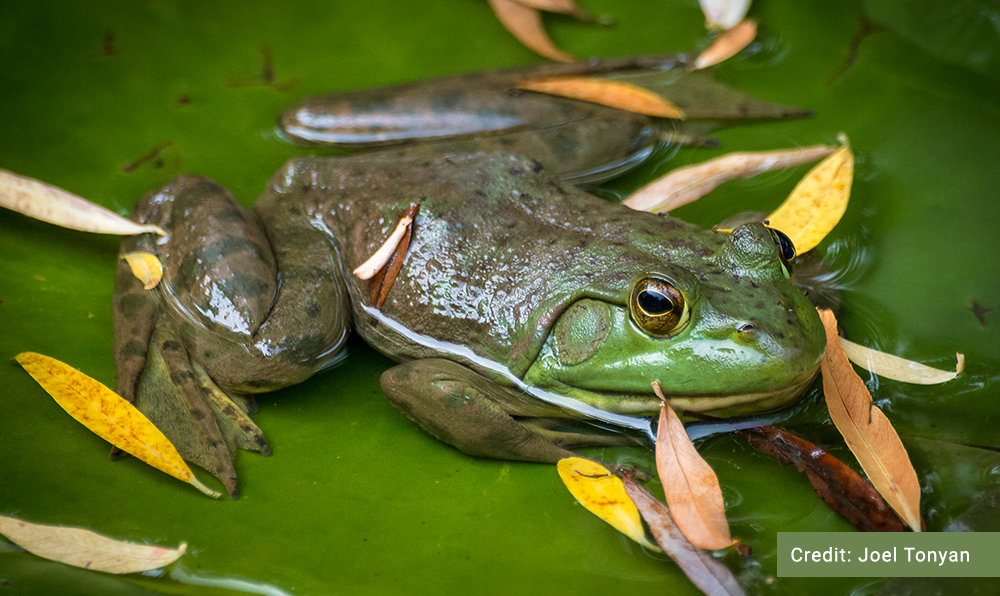
American Bullfrog
Distribution
The Green Frog is native to eastern Canada, and has been introduced to Newfoundland and British Columbia. In British Columbia, the Green Frogs range is restricted to southern Vancouver Island and the Lower Mainland. It is common in the United States with a large distribution, primarily in the east.
Habitat
In Canada, Green Frogs hibernate underwater throughout the winter and are active from April to October, depending on latitude. They are highly aquatic and are almost always found close to water and prefer shallow, permanent springs, swamps, brooks, ponds, or lake edges. Green Frogs may travel up to 1 kilometer from their breeding areas to hibernate in flowing water as these areas are less likely to freeze. Dispersal from their birth ponds is based on environmental factors and there is little evidence of a homing response to natal ponds in following years. Juveniles may use temporary water bodies in the summer and can be found in almost any pool or puddle, including potholes on roads.
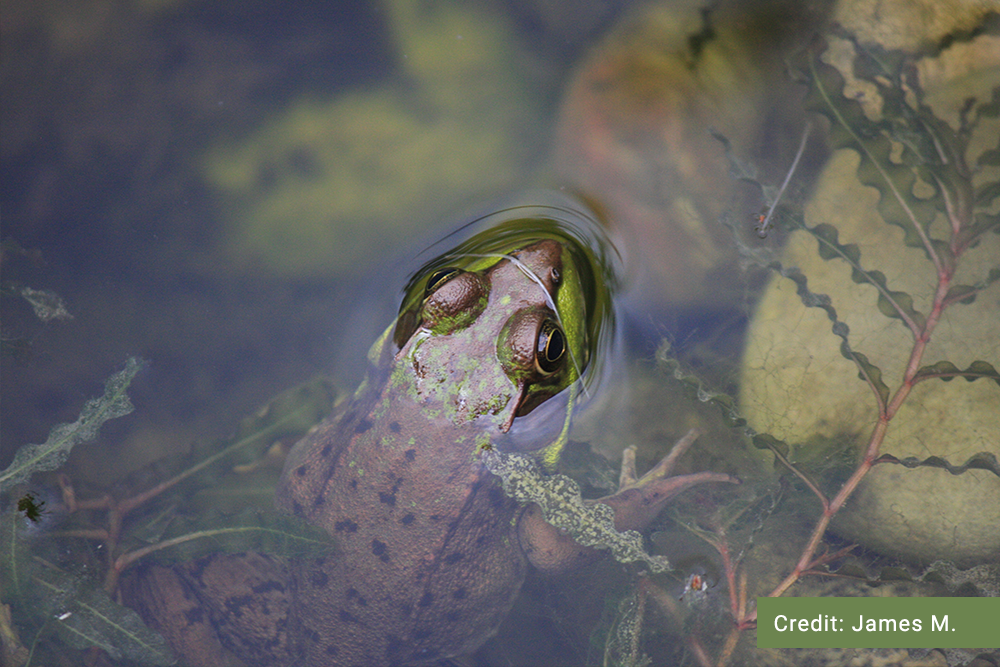
Reproduction
Green Frogs will begin calling to attract mates in late spring to mid-summer and will breed for a prolonged period from June to August. The male will grasp the female in amplexus and fertilization occurs externally in aquatic habitats. The female will lay up to 5000 eggs in a large surface film. Eggs are black and laid in shallow water usually less than 50 cm deep with emergent or floating vegetation. Hatching occurs within a week depending on water temperature and tadpoles will overwinter once, and sometimes twice, before metamorphosis. Due to the long breeding season and long larval period, a variety of tadpole sizes and newly transformed froglets can be found throughout most of the spring and summer. Green Frogs reach sexual maturity 1-2 years after transforming and may live to 5 or 6 years of age.
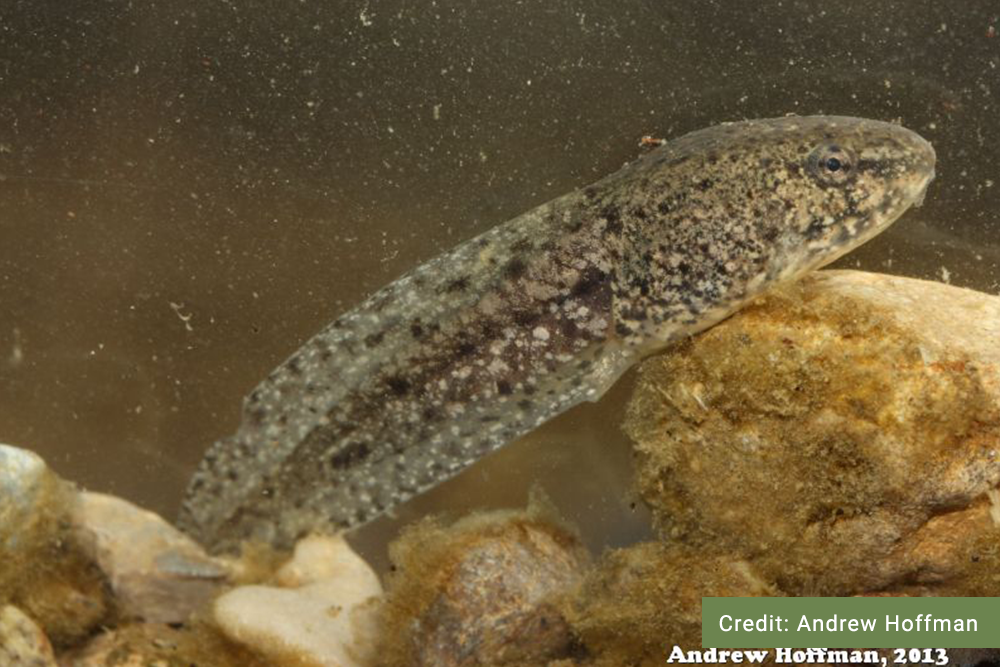
Diet
Green Frogs are both diurnal and nocturnal, and forage in both aquatic and terrestrial habitats for invertebrates like beetles, moths, slugs, spiders, flies, and other insects. Green Frog tadpoles are generalist feeders and will attempt to swallow anything they can capture including insects, spiders, crayfish, shrimp, small snakes, birds, snails, or other frogs.
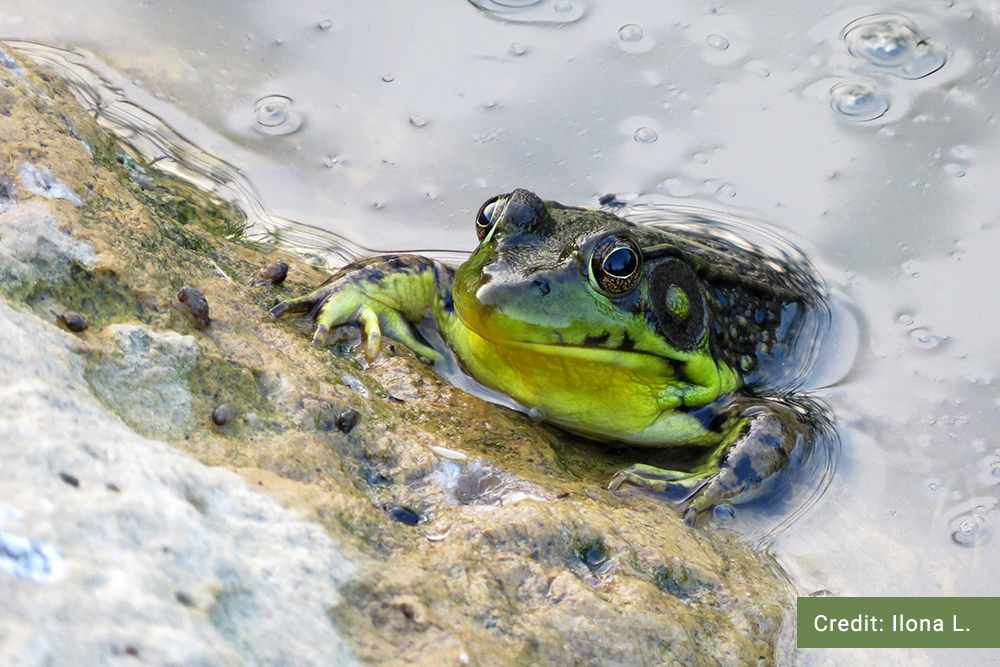
Conservation Status
Global: G5 (2016)
Provincial: SNA (2016)
BC List: Exotic
Learn more about conservation status rankings here
Threats
Green Frogs are common and widespread in eastern Canada and tolerate habitat disturbance better than most frog species. However, much of their habitat, especially in southeastern Canada, has been destroyed in the conversion to agriculture and urban areas. Road mortality can cause long-term population declines in Green Frogs where their aquatic habitats are near roadways. Pollution from pesticides and herbicides, road salt, and sediment from forestry can cause mortality and developmental defects. They may also be susceptible to pathogens such as Chytrid fungus and Ranavirus. Climate change is a threat to all frog species as it may increase the frequency and severity of drought and flood events.
Green Frogs are likely here to stay in British Columbia, but there are ways to help minimize their impact. Green Frogs are known to displace Oregon Spotted Frogs, an endangered species in B.C., making it even more important to ensure humans are not spreading Green Frogs to new areas. Never transport tadpoles or adult frogs, and if you see Green Frogs in a wetland report it to the Invasive Species Council of British Columbia.

Did You Know?
When approached near the edge of a pond, Green Frogs will often leap to escape into the water and let out a loud squeaky call.
Male Green Frogs are very territorial and will aggressively attack intruders during the breeding season.
Male Green Frogs are very territorial and will aggressively attack intruders during the breeding season.
Species Account Author: Marcus Atkins
References
B.C. Conservation Data Centre. 2010. Species Summary: Lithobates clamitans. B.C. Minist. of Environment.
Available:https://a100.gov.bc.ca/pub/eswp/ (accessed May 24, 2021).
B.C. Conservation Data Centre. 2021. BC Species and Ecosystems Explorer. B.C. Minist. of Environ. Victoria, B.C.
Available:https://a100.gov.bc.ca/pub/eswp/ (accessed May 24, 2021).
Matsuda, Brent, David M. Green, and Patrick T. Gregory. 2006. Amphibians and Reptiles of British Columbia. Handbook. Royal BC Museum, Victoria.
https://www.naturewatch.ca/frogwatch/green-frog/#:~:text=Description%3A%20The%20Green%20Frog%20is,tympanum%20and%20prominent%20dorsolateral%20ridges.&text=It%20is%20distinguished%20from%20other,hind%20legs%20have%20dark%20bars
http://www.canadianherpetology.ca/species/species_page.html?cname=Green%20Frog
http://linnet.geog.ubc.ca/efauna/Atlas/Atlas.aspx?sciname=Lithobates%20clamitans
http://a100.gov.bc.ca/pub/eirs/viewDocumentDetail.do?fromStatic=true&repository=BDP&documentId=3221
Available:https://a100.gov.bc.ca/pub/eswp/ (accessed May 24, 2021).
B.C. Conservation Data Centre. 2021. BC Species and Ecosystems Explorer. B.C. Minist. of Environ. Victoria, B.C.
Available:https://a100.gov.bc.ca/pub/eswp/ (accessed May 24, 2021).
Matsuda, Brent, David M. Green, and Patrick T. Gregory. 2006. Amphibians and Reptiles of British Columbia. Handbook. Royal BC Museum, Victoria.
https://www.naturewatch.ca/frogwatch/green-frog/#:~:text=Description%3A%20The%20Green%20Frog%20is,tympanum%20and%20prominent%20dorsolateral%20ridges.&text=It%20is%20distinguished%20from%20other,hind%20legs%20have%20dark%20bars
http://www.canadianherpetology.ca/species/species_page.html?cname=Green%20Frog
http://linnet.geog.ubc.ca/efauna/Atlas/Atlas.aspx?sciname=Lithobates%20clamitans
http://a100.gov.bc.ca/pub/eirs/viewDocumentDetail.do?fromStatic=true&repository=BDP&documentId=3221


